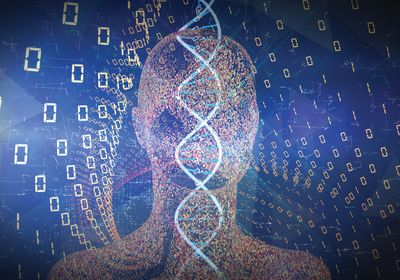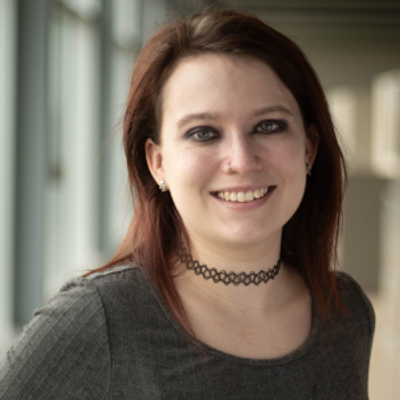ABOVE: David Furman uses artificial intelligence to identify markers and develop new biological clocks to monitor aging. © istock.com, aislan13
In 2007, David Furman was a graduate student at the University of Buenos Aires. That year, he attended a conference where he met Mark Davis, an immunologist at Stanford University. Furman was intrigued by Davis’s ideas about a new approach to studying the human immune system, so he joined Davis’s lab the following year as a postdoctoral researcher.
His first project involved vaccinating individuals with the influenza vaccine and then collecting blood to assess the variety of immune responses in individuals across a range of ages and over time. Amongst different cohorts, they observed biomarkers that correlated with vaccine responses, but one that stood out to Furman was age.1,2
“Across the board—for cytokines, for metabolites, for genes, for cells—they change so dramatically with age, to the extent that you can actually build a very accurate clock predicting chronological age,” Furman said. “That’s where my interest in aging started.”
Focusing on inflammation is really cool, because inflammation is one of the key hallmarks of aging, and it’s connected to many other hallmarks.
—Hao Li, University of California, San Francisco
While collecting data for the multiparameter longitudinal study, Furman, now an immunologist and data scientist at Stanford University and the Buck Institute for Research on Aging, was inspired by the Human Genome Project that created a revolutionary resource for researchers to study genetics. “I thought, why don’t we come up with something similar for the immune system,” he said. Even with 600 participants in his and Davis’s study, he knew that they would need more data points. He reached out to other researchers at Stanford University to pool their cytokine, metabolite, gene expression, and cell datasets to create an immune atlas for common use. This collaboration gave rise to the Stanford 1000 Immunomes Project (1KIP).
“That’s a really cool thing, and it’s being done at a scale that a lot of us can’t do, so at some point, we will all be the benefactors of his work with the open-source nature of the data and everything,” said Matthew Yousefzadeh, a biologist at Columbia University. “[Furman is] a phenomenal scientist and doing great work on aging.”
However, while the project held a lot of opportunities, it introduced a new challenge: managing all of the collected information. “I was sitting in, drowning in data,” Furman recalled. To parse the multitude of parameters in the data sets, Furman needed the power of computational biology.
Aging Research Meets Artificial Intelligence: Building the Human Immunome
With the data from 1KIP too massive for typical data analysis software, Furman turned to machine learning to identify meaningful patterns in the vaccination data.1 Today, using artificial intelligence (AI) to analyze large data sets, Furman’s team identifies what parameters are most important for a given outcome. With 1KIP data and deep learning models, Furman and his group demonstrated that inflammatory molecules correlated with vascular health and aging, and they developed a metric based on inflammation related to age, called iAge.3
“Focusing on inflammation is really cool, because inflammation is one of the key hallmarks of aging, and it’s connected to many other hallmarks,” said Hao Li, a systems biologist studying the mechanisms of aging at the University of California, San Francisco, who has not worked with Furman in the past. “Essentially, it’s involved in the aging of all kinds of tissues and organs.”

The team showed that iAge could predict biological aging and potentially be used as a diagnostic tool for evaluating overall health in aging. Additionally, the model identified CXC motif chemokine ligand 9 (CXCL9), a cytokine that promotes inflammatory responses as well as the production of blood vessels and bones, as a major contributor to inflammatory-driven aging. They showed that CXCL9 decreased the function of mouse aorta tissue, and that the molecule correlated with cardiovascular health in humans. “That’s really nice to be able to go from very high above and gradually zoom in to specific features that you can do intervention [with],” Li said.
“It’s going to be really useful even going forward,” said Yousefzadeh. He contrasted the circulating blood factors from Furman’s iAge clock to previously described methylation clocks of aging.4,5 “It’s easier to measure. It’s probably less expensive to some degree. Once you can settle upon the factors that are most prevalent, you could probably create custom multiplex [enzyme-linked immunosorbent assays], and that fits into the clinical workflow versus some of these epigenetic clocks.”
Recently, Furman and his team trained a new algorithm on functional parameters associated with aging and DNA methylation. The clock, described in a preprint, correlates methylation with physical and mental capacity to monitor aging health.6 Yousefzadeh commented that factors like psychological stress and social determinants of health are often not well represented in data. “He’s not only training his clock on blood factors, but it looks like it’s being trained on actual functional quality of life factors too,” Yousefzadeh said. “In some ways, I think those are the most meaningful ones of all.”
Microgravity Aids Aging Research
While cross-sectional studies and data repositories provide troves of information for researchers, ultimately, the goal is to study aging in individuals over time. However, that is challenging. “The main problem in aging research in humans is that you have to wait too long,” Furman said. “[Longitudinal] studies are extremely expensive, and the grant cycles for federal funding are only five years, so you can never fund this with federal funding.”
The solution, it turned out, was in the cosmos above his head. In 2019, Daniel Winer, an immunologist and current collaborator of Furman at the Buck Institute for Research on Aging, was watching The Expanse, a science-fiction show involving space travel. Winer’s experience with mechanical forces in immune cells made him curious about why the characters didn’t have a solution to counteract microgravity.
“I texted [Furman] and was like ‘we definitely have to look at how microgravity influences immune function and use your pipeline to make drugs against it,’” Winer recalled.
The idea took off when a scientist at the National Aeronautics and Space Administration (NASA) contacted Furman based on his research in inflammation and aging to study the effects of space on astronaut health. This led to joint NASA grants; Furman, Winer, and other collaborators showed that spaceflight altered immune responses in astronauts.7
In 2022, Furman and Winer started a company, Cosmica Biosciences, focused on using knowledge from space science to develop longevity interventions. Subsequently, Furman developed a model of artificial aging using simulated microgravity to study its effects on blood cells.8 This provided him and his team a platform to assess interventions that can delay or reverse the effects of aging; they are currently studying these in immune organoids. “That’s the next level of the 1000 immunomes [project],” Furman said. “I can see how those immune organoids are aging in 24 hours by about eight years.”
That’s a really cool thing, and it’s being done at a scale that a lot of us can’t do, so at some point, we will all be the benefactors of his work with the open-source nature of the data and everything.
—Matthew Yousefzadeh, Columbia University
“I can see which features, which biological pathways, change with age in an individual in a trajectory manner,” Furman explained. “I can start mapping those to different compounds and just start adding those compounds in my cultures in the accelerated aging machine and see which ones work to reverse aging pathways in the immune system.”
“[Furman’s] democratizing the use of high dimensional immune analysis data for the purposes of aging, in the analysis of multimorbidity,” Yousefzadeh said. “I don’t have to go and recreate the wheel. David created a really nice wheel, and he’s showing you how to use it.”
Overcoming the Challenges of the New AI Frontier
While AI holds enormous potential for applications like Furman’s, there remain many challenges in its use in biological research. One issue pertinent to Furman’s research is the balance between patient privacy and access to data to build robust models. “We have to respect patient privacy, but because we are so early in this journey of understanding what are the boundaries, I think we’re overly cautious,” said Furman. As researchers and review boards alike become more adept at incorporating AI, Furman expects that this limitation will be resolved.
Additionally, Furman pointed out difficulties in combining data sets from different platforms as an ongoing challenge in using AI in biological research and, separately, learning how to handle data from a single individual. “When you have a huge amount of data in an individual…there’s not very clear methods to cope with this n-of-one issue,” he said. Addressing these limitations could expand the potential use of AI within and across research groups.
“The amount of data that’s being produced right now by scientists is just enormous compared to what it was like 10 years ago or 15 years ago,” Winer commented, adding that AI will hopefully be able to condense large data sets and pull out new or interesting findings.
“AI has a potential to make some really interesting predictions,” Li said. However, he added that, at this time, many of these are centered in correlations as opposed to causal relationships, but this is an ongoing field of research.
About Furman and his team’s contributions, Winer said, “They’re making a significant impact in the field of computational immunology, especially pertaining to bioinflammatory or immune related biomarkers of aging, and also including new ways to measure new metrics…of aging.”
David Furman is the founder and chairman of the scientific advisory board of Edifice Health and is the founder and chief scientific officer of Cosmica Biosciences.
- Furman D, et al. Apoptosis and other immune biomarkers predict influenza vaccine responsiveness. Mol Syst Biol. 2013;9(1):659.
- Furman D, et al. Cytomegalovirus infection enhances the immune response to influenza. Sci Transl Med. 2015;7(281):281ra43.
- Sayed N, et al. An inflammatory aging clock (iAge) based on deep learning tracks multimorbidity, immunosenescence, frailty and cardiovascular aging. Nat Aging. 2021;1(7):598-615.
- Horvath S. DNA methylation age of human tissues and cell types. Genome Biol. 2013;14:3156.
- Levine ME, et al. An epigenetic biomarker of aging for lifespan and healthspan. Aging. 10(4):573-591.
- Fuentealba M, et al. A novel blood-based epigenetic clock for intrinsic capacity predicts mortality and is associated with clinical, immunological and lifestyle factors. bioRxiv. 2024.08.09.0607252.
- Kim JK, et al. Single-cell multi-ome and immune profiles of the Inspiration4 crew reveal conserved, cell-type, and sex-specific responses to spaceflight. Nat Commun. 2024;15(1):4954.
- Wu F, et al. Single-cell analysis identifies conserved features of immune dysfunction in simulated microgravity and spaceflight. Nat Commun. 2024;15(1):4795.




